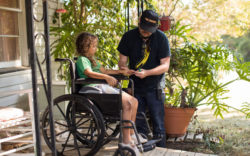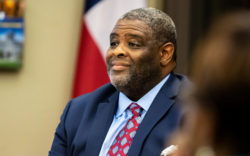Among Clarke County students now celebrating their high-school graduation is a group of nearly 300 who, just two years ago, may not have ended up with a diploma at all. Thanks to a two-year, grant-funded program through Family Connection-Communities in Schools, these students were identified, brought into the fold and now are not only leaving with a diploma, but many are also moving on to college.
Graduates, family and friends recently gathered at the Georgia Museum of Art to celebrate this milestone, but also to ponder the future of the Athens Students Connect to Success program, since the startup funding provided by the AT&T Foundation is set to expire. “The [Family Connection-Communities in Schools] board has been raising funds, and I’m hoping the Board of Education will step up and pay the difference,” said Tim Johnson, the organization’s executive director. “There’s a lot of conversation about equity, or lack thereof, in outcomes for students. I don’t think any program is addressing that as effectively as this.”
The program’s focus is simple but also wide-reaching. Thanks to the grant, Family Connection-Communities in Schools placed five “site coordinators” in Clarke County’s three high schools: Cedar Shoals, Clarke Central and Classic City. Across the three schools, the coordinators connected with 276 students identified as “high risk”—this might mean they were identified for grades or behavioral issues, but they also targeted students who weren’t getting noticed, said Johnson.
“The reason there are inequities is because of what happens outside of the classrooms more than what happens in the classrooms, so staff members can connect kids to what they need outside the classroom,” he said. “These kids might not be the troublemakers; what happens a lot, especially with people who haven’t been successful, is they start internalizing it.”
The site coordinators met one-on-one with each of their assigned students for a conversation. But while the students considered it just that, the staff members were compiling information into a spreadsheet that turned into a checklist of goals. It’s a formula that Johnson has used for years through the Communities in Schools model, but the grant allowed its use to scale up.
“We have access to their grades and their behavior records, and we’re encouraging them and having conversation[s], but they don’t realize what they’re doing is making their plan and making goals,” said Kijuana Crawford, a site coordinator at Cedar Shoals High School who was assigned 50 students over the past year. “So they’re saying, ‘Yeah, I didn’t pass math last year, but I want to get back on track.’ And then what we do is we make a database, and we put in their goals and make a plan for them.”
Crawford was one of two site coordinators at Cedar Shoals, and she said the trust and relationship they developed with their students was evident not only in those they directly worked with, but also among their friends and younger students.
The graduating students began visiting the site coordinators as juniors, but there are also rising sophomores and juniors who have dropped by to vent, ask for advice or just chat. “We have an open-door policy,” Crawford said. Her job is different from a school counselor, she said, because of the issues they grapple with. Her position allows her to focus on the external factors that specifically address a student’s academic success. “So, it’s kind of shaky knowing that we might not see them next year. I’ve been preparing them and reminding them to make good choices even if we’re not here.”
Overall, the program reached 276 students, with 96 percent of them staying in school and 97 percent of them graduating on time (according to numbers from the program’s first year; 2018 numbers are not yet available). Ninety-eight percent of the students in the program are people of color.
At the event celebrating their accomplishment, Cedar Shoals senior Rydaisha Willingham said she’s looking forward to the next step: studying business at Savannah State University. She said the conversations she had with her site coordinator helped keep her focused, especially through the college application process. As their conversations continued, she began to see how there was a larger plan in place for her.
“They helped me apply for colleges, and it was more personal, and they were friendlier,” she said. Looking back, the hardest part wasn’t necessarily the preparation or the forms to fill out. Rather, Willingham said, it was anticipating the next step. “The waiting—just trying to see if I got accepted.”
Like what you just read? Support Flagpole by making a donation today. Every dollar you give helps fund our ongoing mission to provide Athens with quality, independent journalism.









